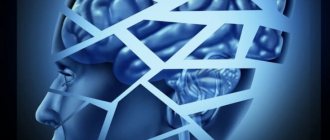Each person is unique - he has certain talents, but it happens that an action that is simple for most people becomes a real problem for some. And this does not always indicate low intelligence or developmental delay. So, in the case of dyscalculia, the reasons lie in a purely biological origin .
Dyscalculia or “mathematics dyslexia” refers to a series of disorders that are associated with dysfunction of the neural connections of the brain, which causes the further development of cognitive impairment and the psychopathology of dyscalculia.
How can this hinder the child in the future?
- During the training period, the student will demonstrate an inability to learn arithmetic and mathematical sciences in general.
- These people have difficulty interpreting numeric symbols and performing basic addition, subtraction, multiplication, or division calculations.
- A child with dyscalculia confuses numbers and signs and cannot count in his head or work with abstractions. He has difficulty doing tasks that rely on mathematical calculations.
- In adulthood, the disorder may manifest itself as problems related to time management.
- Having difficulties with coordination of movements.
However, such a diagnosis is not a death sentence. Most people cope with this feature of their brain and are realized in areas where the need for calculations is minimized. They often become artists, actors, linguists, or succeed in the philological field.
An experienced speech therapist will help you recognize dyscalculia in a timely manner and adjust your child’s educational program. A specialist will confirm or refute the diagnosis and help both the child and his parents cope with the situation.
Description
Dyscalculia is a violation of the ability to study arithmetic with normal intelligence.
According to ICD-10 it has code F81.2. It manifests itself as an inability to recognize digital symbols, difficulties with addition, subtraction, multiplication and division. Combined with the delayed emergence of the ability to estimate the size of objects and recognize geometric shapes. Accompanied by a lag behind the school curriculum. Dyscalculia must be distinguished from acalculia - a secondary loss of the ability to work with numbers in children and adults after severe head injury, tumor or cerebral hemorrhage. Dyscalculia is detected in childhood when a child is learning to count and belongs to the category of disorders of the development of learning skills. It is detected to varying degrees in 6% of children, and is equally common in patients of both sexes. Often combined with attention deficit and dyslexia.
Reasons for development
Counting disorders are caused by genetic, psychological or organic reasons. In practice, most children exhibit a combination of several factors.
- Hereditary burden . Children often have a parent or close relative who also has dyscalculia. The genetic basis of the disorder has not yet been established.
- Negative learning experience . Difficulty in counting occurs under the influence of excessive or age-inappropriate demands, too strict punishment for mistakes, difficulties in the relationship between the child and the parent or teacher.
- General psychological factors . Dyscalculia often develops in children from dysfunctional families, formed against the background of family physical or emotional violence, overprotection, inconsistent or harsh authoritarian upbringing.
- Organic brain lesions . The causes of dysfunction of brain structures in dyscalculia of organic origin are intrauterine infections, intoxication of the mother during pregnancy, complications during gestation and childbirth.
Pathogenesis
At the initial stage of learning, dysfunction of the intraparietal sulcus plays an important role in the development of organic dyscalculia. Subsequently, damage to the posterior associative cortex, frontal lobes and subcortical regions, as well as deterioration of interhemispheric interactions, become obstacles to learning to count. Psychogenic difficulties in learning arise from psychological neglect, fear of punishment, and lack of self-confidence.
Classification
Taking into account the predominance of one or another type of disorder, 6 types of dyscalculia are distinguished:
- Lexical . The child learns arithmetic concepts well by ear, but has difficulty working with numbers, equations and examples when he sees them on paper.
- Verbal . The patient solves written problems normally, but has difficulty when trying to name mathematical categories or recognize them by ear.
- Graphic . The student successfully uses mathematical symbols in oral speech, but is lost when it comes to writing them.
- Practognostic . The child experiences difficulties when trying to transfer concrete examples to the level of abstractions or abstractions to the level of concrete examples.
- Ideognostic . The patient cannot carry out mathematical calculations in his head. To solve, he needs a factual basis: using objects, drawing or writing data on paper.
- Operating room . Symbolization suffers. The student successfully understands numbers, recognizes “more and less,” but does not remember numbers and special signs well.
In practice, pure types of dyscalculia practically do not occur; mixed forms predominate.
Prevention methods
Precautionary measures to prevent dyscalculia can be carried out in early preschool childhood. First of all, the most complete correction of existing neurological pathologies should be carried out. At an early age, you can start learning basic mathematics in a playful way.
Parents should clearly demonstrate to their child how to count objects, shapes and perform basic mathematical tasks, for example, while swimming, you can ask your child to count blue balls or catch three red balls with a net. When teaching a child to count, it is necessary to carefully pronounce the names of numbers, and then arithmetic operations. You can show the number of objects to the child on your fingers or using small toys and objects. Gradually, you need to teach your child to correlate the number of objects with a specific number.
To prevent a child from developing operational dyscalculia, he must be taught the rules of counting and the order of mathematical operations. To prevent verbal and lexical problems, it is necessary to ask the child to say the name of the numbers when counting, and when looking at various figures and other objects - their color and shape. Parents should monitor the correct use of certain symbols and, if their child makes mistakes, calmly correct them, without using harsh punishments.
To prevent the occurrence of dyscalculia in graphic form, it is necessary to pay special attention to the development of the child’s visual memory, fine motor skills, coordination of movements through finger and outdoor games, collecting cut pictures, cubes, puzzles, playing with small parts of the construction set, stringing beads on a cord, identifying them shape and color. The productive activities of children are very effective in this regard - modeling, drawing, appliqué, making crafts, origami.
Moms and dads must pay attention to the development of thinking and memory in the child, and then, in the future, the occurrence of dyscalculia can be avoided.
Symptoms
Photo: mel.fm
Manifestations of dyscalculia are determined by the type of disorder and the age of the child. The first signs are detected in preschool age, when the baby begins to comprehend the simplest arithmetic concepts. The clinical picture unfolds most clearly in the primary grades, since during this period children have to intensively master counting skills. In the absence of corrective measures, violations persist in high school and middle school, and then are observed throughout life.
Preschool age
Children do not understand well what a number represents and cannot count within ten. They have difficulty comparing the sizes of objects; for example, they find it difficult to choose a smaller ball. They are not able to count objects of the same type among dissimilar objects, for example, apples in a basket of apples and oranges.
When trying to teach recognition of written numbers, a child cannot create a connection between the image and the verbal sound. Patients with dysgraphic dyscalculia experience many errors when writing numbers, especially those that superficially resemble each other. Children confuse symbols and, when writing, turn them upside down or in a mirror image.
Verbal dyscalculia is manifested by errors in recognizing similar-sounding numbers. The inability to plan and control actions with numbers is characterized by the inability to follow instructions, start counting from a certain number, or finish counting at a certain point.
Junior school age
Children cannot remember the signs “plus” and “minus”, “greater than” and “less than”. They do not understand how to write phrases used to compare numbers (for example, “less than”). Practical aids are used for calculations: sticks, fingers, pencils.
They cannot learn the multiplication table and the procedure for performing sequential mathematical operations. Some students read examples backwards, for example, in the “10-2=” problem, ten is subtracted from two. They get lost when the appearance of the problem changes (they cease to understand that this is the same example when numbers are written not in a line, but in a column).
Middle and high school age
Pupils do not master the exact sciences well. They do not understand what the essence of the task is, cannot analyze the conditions, and forget information, even when the text of the task continues to be in front of their eyes. Children have difficulty distinguishing between important and unimportant information if this information is associated with numbers and calculations.
Tables and graphs do not make it easier, but make it even more difficult to analyze digital data. In everyday life, patients find it difficult to determine the date, have difficulty calculating time and orienting themselves in unfamiliar places, cannot use maps, and have difficulty perceiving information about bus and train schedules on the corresponding boards.
Helpful tips for children with dyscalculia
- When solving a mathematical problem, try to visualize it, draw its content.
- Spend maximum time looking at pictures, drawings, and diagrams that illustrate the task.
- Read the problem, example, or equation out loud and listen to the sound, imagining everything you hear.
- Ask for a sample solution to similar tasks.
- Come up with a life situation where such a solution could be applied. Or ask an adult to help you.
- Write more and more often on pieces of paper in the box. When completing tasks on separate worksheets, choose those that do not have marks made by someone else’s hand - this is extra and unnecessary visual information.
- Give up your fear of numbers, formulas, problems and examples. Moreover, take a lot of time to learn the formula or axiom. Use ready-made or create mnemonic phrases and memorization systems.
Diagnostics
Photo: emmaclinic.ru
The diagnosis of dyscalculia is made by a neuropsychologist or psychiatrist based on a neuropsychological examination and interview of the child to determine the level of mathematical concepts. When studying the medical history, the specialist identifies possible provoking factors: organic neurological and mental disorders in the child, dyscalculia in close relatives, unfavorable educational or family environment.
To exclude other causes of learning difficulties, the level of intelligence, memory, attention, emotional and volitional qualities, and speech development are assessed. Dyscalculia is differentiated from pedagogical neglect, mental retardation, and other conditions.
The main thing about dyscalculia
Dyscalculia is a disease that needs to be treated.
With this condition, the child often does not have learning delays in subjects in which there is no need to carry out calculations. In adults, the condition can develop due to brain damage. Depending on which of them occur, therapy is carried out. The prognosis with timely initiation of treatment is usually favorable.
Are you experiencing dyscalculia? Share your treatment experience in the comments.
Kholod Victoria · 11 Mar, 2019
Treatment
Photo: onnispb.ru
Treatment of dyscalculia is carried out during psychocorrection work. The training program includes exercises that stimulate the activation of old and the formation of new neural connections in the areas of the brain responsible for counting, perceiving and distinguishing mathematical symbols, and assessing relationships between objects. The work focuses on developing the following skills:
- Spatial functions . Children are taught to navigate in space, recognize concepts related to size and direction, and determine where the left and right sides are. During the exercises, patients establish relationships between real objects and images of objects, learn the location and direction of movement of objects.
- Speech . At the initial stage, children are taught basic mathematical terms and concepts related to arithmetic operations. Then they move on to exercises on classifying objects, learning to count, and freely using numbers in conversation.
- Basics of Arithmetic . Students master basic mathematical operations, learn to reproduce them in various modalities: in oral speech, in the process of writing, when using objects. The specialist helps them master all stages of the solution, from understanding the meaning of the problem to choosing the calculation logic and its practical implementation. The division of a whole into parts and its reassembly from elements is studied. The skill of writing numbers and other mathematical symbols is strengthened.
Historical aspect
The term dyscalculia dates back to approximately 1949. It comes from the ancient Greek word δυς, meaning "bad" and the Latin calculāre, meaning "to count." In 1974, a Czechoslovakian scientist defined dyscalculia as “a structural disorder of mathematical ability.” His research proved that learning disabilities were caused by problems in certain parts of the brain that control mathematical calculations, and not because people with these symptoms were “mentally retarded.” Nowadays, researchers sometimes use the terms "mathematics dyslexia" or "mathematics learning disability" when referring to this condition.
The term is often used to refer to the inability to perform arithmetic operations, but is also defined by some educators and cognitive psychologists, such as Stanislas Dechen and Brian Butterworth, as a more fundamental inability to conceptualize numbers as abstract concepts of comparative quantities. Researchers consider this skill to be fundamental, the one on which other mathematical abilities are built.
More often, dyscalculia develops as a genetically determined learning disability that affects a person's ability to understand, remember, or manipulate numbers or number facts (such as the multiplication tables). Symptoms of dyscalculia include problems with simple counting, inability to remember simple arithmetic facts such as addition, subtraction, etc. But to date, few symptoms of the disease are known as little research has been done.
Folk remedies
There are no traditional methods for treating dyscalculia. It is possible to do independent homework with young children, helping to prevent the development of mild forms or mitigate the course of more severe disorders. To prevent various types of dyscalculia, the following methods are used:
- Practognostic . Solving simple problems with pronouncing arithmetic operations and simultaneous use of visual aids: sticks, pencils, fingers.
- Graphic . Fine motor skills training.
- Verbal . Memorizing the names of numbers and arithmetic operations, repeating material during a conversation.
- Dyslexic . Studying sizes and shapes, games to recognize numbers and mathematical symbols.
- Operating room . Memorizing and reproducing calculations, using mathematical terms during a conversation.
The information is for reference only and is not a guide to action. Do not self-medicate. At the first symptoms of the disease, consult a doctor.
Games and tips for a confirmed diagnosis
An important component of success when teaching a child with a similar disorder is positive motivation. And family support plays an important role in the learning process, because it is among close people that the child receives emotional support and learns to work hard. The main rule is to give it time to understand, even if the task seems very simple to you.
- Culinary . Counting training and “communication” with numbers should become an integral part of life, so it is important to apply it in different aspects. Kids can be involved in the process of preparing the recipe. The baby’s task will be to prepare the required amount of ingredients (3 carrots, 5 potatoes). This is also true for going to the store. Let your child count and put 2 packs of pasta and 5 yoghurts into the basket. For older children, you can make it more difficult by adding prices. He must find out which yogurt is the most profitable to buy, etc. Ask the child to set the table with the expectation that he will have to count the required number of guests, forks, spoons and other utensils on the table.
- Watchmaker . Try to keep your baby occupied for hours, let him start watching a cartoon or treats at a certain time. Ask him what time it is or when you should leave the house. Reward your child with the position of “time keeper” and reinforce the importance of this event.
- Counting non-stop . A great practice is to count the objects around you. When going for a walk, a child can count people, cars or entrances passing by. A game of searching for certain numbers will be productive. During a walk, a child can look for the number 3 on everything that surrounds him.
In this simple way, you will motivate your child to pay attention to the numbers and interact with them, which will help reduce his level of discomfort and tension. But without professional help, it is difficult to achieve the necessary adjustment, and the sooner you contact a speech therapist, the easier it will be for the child in the future.
Publication date: 08/17/2021. Last modified: 08/17/2021.
general information
Disturbances in the development of mathematical operations and abstract concepts are quite common - in 5-6% of schoolchildren. In most cases, pathology is not diagnosed, as it is perceived by parents in the form of character traits and a penchant for humanitarian subjects.
At what age can we talk about dyscalculia?
Psychologists recommend making a diagnosis no earlier than 5-6 years. This age corresponds to the preschool period, when learning and the formation of basic skills and knowledge in working with abstract symbols and actions begin.
It is important to distinguish between the concepts of acalculia and dyscalculia. The main differences between them are that with dyscalculia the child has a partial impairment in mastering arithmetic, while with acalculia the ability to count is completely absent. The latter violation is observed in cases of serious brain damage or pedagogical neglect in upbringing.










